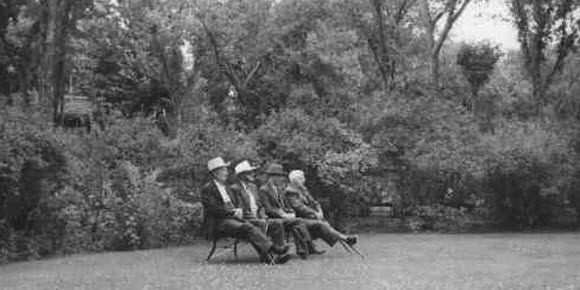by Bruce Cherney (part 4)
Just three years after the Crescentwood auction sale of 133 lots, on June 25, 1920, Charles Henry “C.H.” Enderton, the founder of the subdivision, died while driving his automobile on Academy Road after taking an excursion through Assiniboine Park. He was driving a lady friend home when he collapsed. Twenty minutes later, he was pronounced dead of a heart attack at the accident scene by physicians. Death, according to the doctors, was instantaneous.
Enderton was born in Lafayette, Indiana, on May 4, 1861, and was orphaned by the age of three. He was educated at De Pauw University and began a law practice in St. Paul, Minnesota, in 1884. He came to Winnipeg in 1890 and started a career in real estate. He was a co-founder of the Winnipeg Real Estate Exchange (now WinnipegREALTORS®), which was established in 1903.
His firm also owned the Enderton Block at the southeast corner of Portage Avenue and Hargrave. There were actually two Enderton buildings. The first burned down on January 11, 1918. It was replaced by a three-storey building, also named after the Crescentwood real estate developer, which became the Mitchel-Copp Building in the 1950s. The Mitchell-Copp Building was demolished in the 1960s to make way for the 17-storey Bank of Montreal Building.
In 1910, Enderton was listed in the Winnipeg Telegram as one of Winnipeg’s 19 millionaires. He left an estate valued at $1.2 million, but he was unmarried. His will named his sister and her two daughters, as well as his brothers and a few close friends, all of whom lived in the U.S., as the beneficiaries. De Pauw University was also named as a beneficiary in his will, as were the General and Children’s hospitals in Winnipeg and the Winnipeg Boys’ Club.
In 1921, succession duties collected by the provincial government totalling $150,000 and ate into the final tally for the estate.
After the payment of debts and expenses, his estate was said to be worth only $400,000. It is unclear who, among the many beneficiaries listed, actually received money from his estate.
By 1924, the Enderton estate was still in limbo, as much of it was still tied up in Crescentwood property. Advertisements for the sale of 43 lots held by the Enderton estate began to appear in the Manitoba Free Press in March.
“From every standpoint these forty-three lots represent the very cream of unbuilt real property in the whole City of Winnipeg,” claimed a March 7, 1924, ad in the newspaper. “They are occasional lots and corners on Wellington Crescent, Wilton, Cambridge, Oxford and Waverly Streets, on Yale, Harvard, Kingsway, Dromore Avenues and Academy Road, many of them east of Harrow and Guelph Streets.”
Enderton had reserved the lots for himself “for sentimental reasons on the occasion of the final dispersal of Crescentwood property in 1917.”
According to the ad, “Mr. Enderton’s conception of Crescentwood was that of a beautiful place for homes to be happily lived in by nice people, and his executors they are carrying out what would be his wished in now making these last lots available for homes.”
The ad claimed the lots were affordable and “will not be priced on the basis of book value.”
Another ad stated that the lots would be sold for $30 to $60 per foot of frontage. This was similar to the price range realized for the 133 lots sold during the September 1917 auction. In effect, Crescentwood lot prices hadn’t changed in seven years.
The sale was under the auspices of Alfred J. Andrews and Clarence Day Shepard, of C.H. Enderton & Co., who were the executor’s of Enderton’s estate.
“A large number of building sites comprising part of the C.H. Enderton estate in Crescentwood were also sold ... and a number of houses have already been built on these sites ....” according to a report in the December 10, 1924, Winnipeg Tribune.
Ironically, Enderton never lived in Crescentwood. Instead, he preferred to live in the apartment building known as Fort Garry Court at 160 Main St., across from Union Station. Earlier, it had been called the Strathcona Block. The apartment building was demolished shortly after a major fire, which killed five people and left another 175 homeless, on February 1, 1976.
Enderton Park, the small two-acre park in Crescentwood along Ruskin Road, commonly referred to today as “Peanut Park,” and originally called Crescentwood Park, was renamed in Enderton’s honour in 1924. The name change was at the suggestion of Shepard and Andrews, the executors of the Enderton estate.
“The parks board has received a letter from C.D. Shepard, who states that he and his executor, A.J. Andrews, think the name of Mr. Enderton ‘would be a very fitting one for this breathing space which your board has made so attractive’” (Tribune, July 8, 1924).
In 1993, the Crescentwood Home Owners Association spearheaded a campaign to rename, what they had only known as “Peanut Park,” after Enderton, apparently unaware that this name had been officially applied years earlier to the park (Historic Sites of Manitoba: Crescentwood Park/Enderton Park /“Peanut Park,” 11 Ruskin Row, Winnipeg).
(Next week: part 5)



